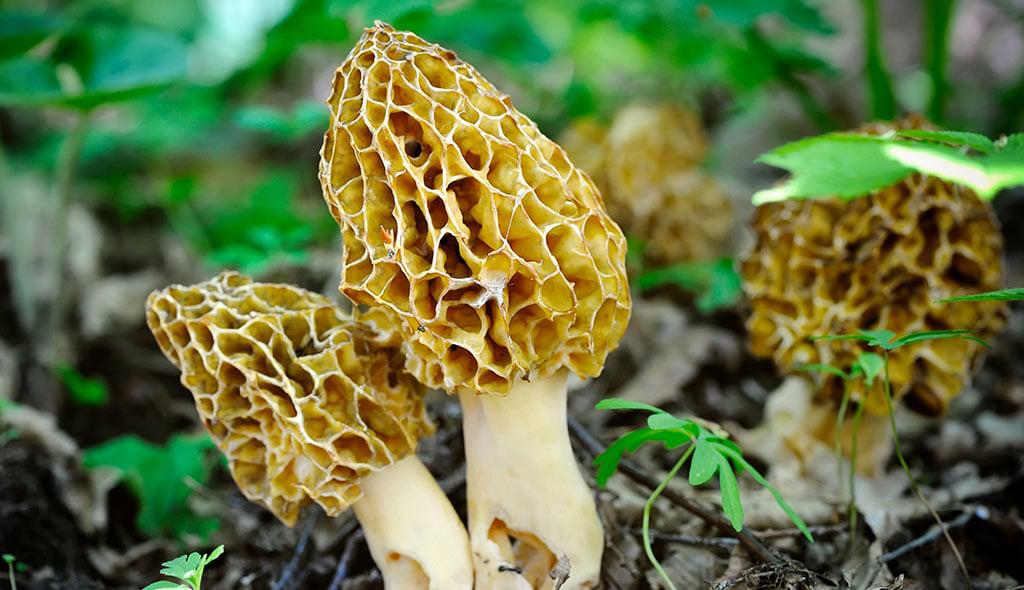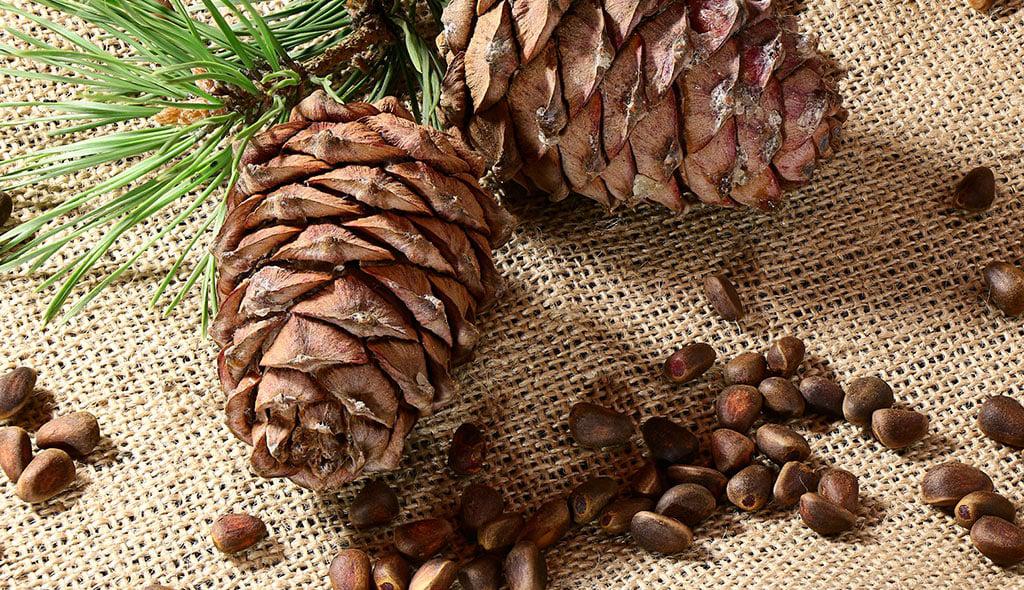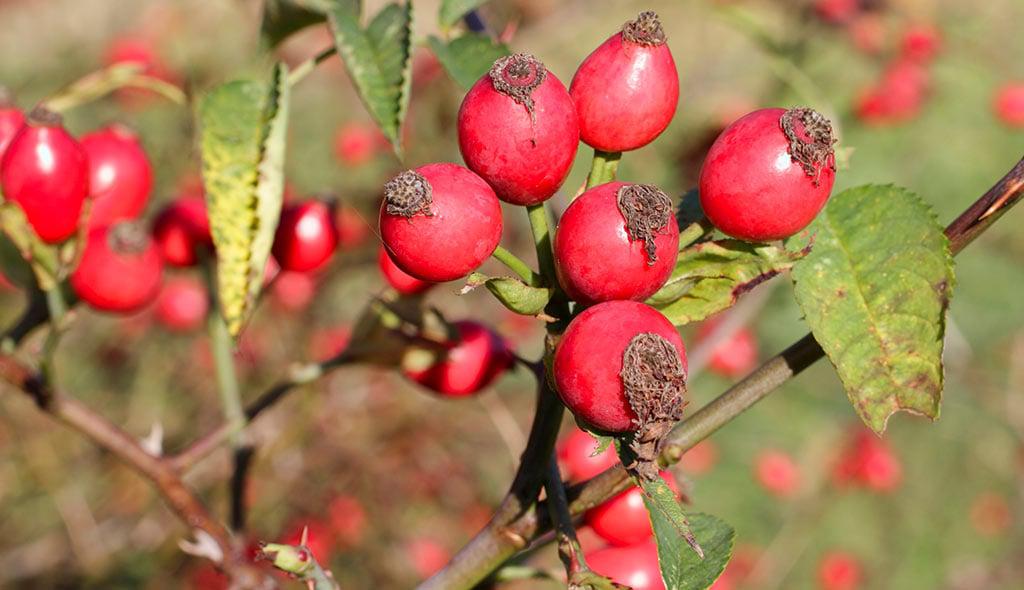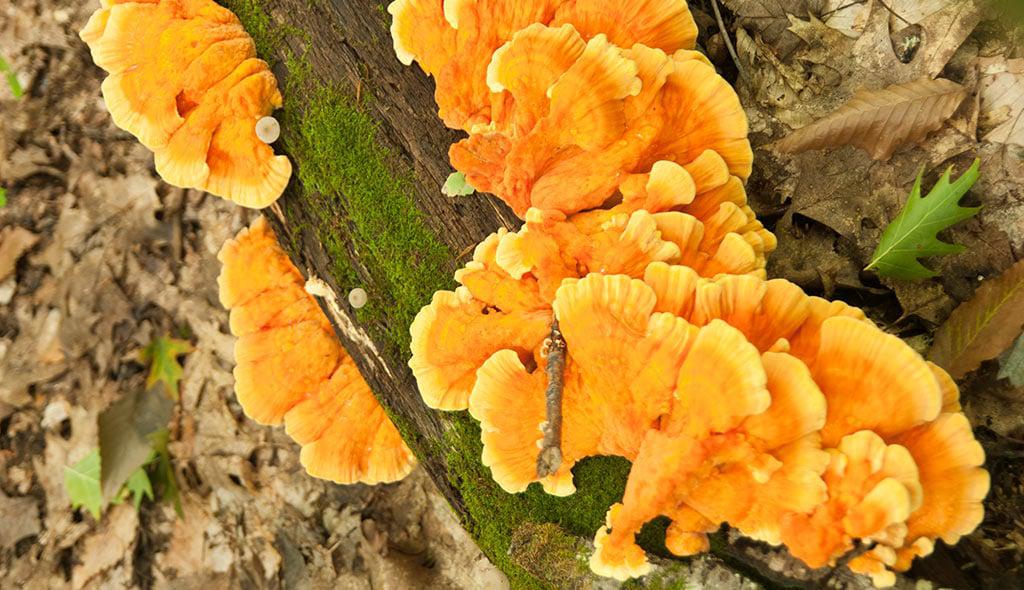 Once you start learning about wild, edible plants and fungi, you might just realize that you’ve been hiking through forests of food. Anywhere you are, there are likely lots of edible plant options, including berries, seeds, flowers, nuts, roots, and foliage. Sometimes, whole plants are edible. Whether you want to forage for fun, add wild food to your backpacking diet, or keep foraging knowledge tucked away in case of emergency, this guide will give you an introduction to foraging for food.
Once you start learning about wild, edible plants and fungi, you might just realize that you’ve been hiking through forests of food. Anywhere you are, there are likely lots of edible plant options, including berries, seeds, flowers, nuts, roots, and foliage. Sometimes, whole plants are edible. Whether you want to forage for fun, add wild food to your backpacking diet, or keep foraging knowledge tucked away in case of emergency, this guide will give you an introduction to foraging for food.
Foraging safety
Before you go foraging, equip yourself with knowledge. Learn how to identify plants before you consume them — don’t just eat anything that looks edible. Not all plants are edible, and some edible and poisonous plants look similar. And remember, when in doubt, don’t eat it. Get in the habit of carrying around a book describing and picturing edible plants to help you identify safe plants to eat. A guide that is local to your area will be especially helpful. I’ve included a list of general suggested books at the bottom of this article to fuel your foraging adventures. The Universal Edibility Test can save you in a survival situation, such as if you get lost while hiking and run out of food. Learn this test in case you’re in dire need and don’t have a guide to wild, edible plants on hand. This test does not apply to mushrooms, which should only be eaten with positive identification.
General rules to follow when foraging
These basic guidelines are important to keep in mind on any foraging experience, whether you’re a beginner or veteran forager:
- Don’t assume that if an animal eats something, it isn’t poisonous to humans.
- Foraging can be fun for the whole family when done safely. Don’t let your children eat any part of a plant without your permission.
- Avoid plants that have a strong, disagreeable odor. Crush the leaves and smell them if they don’t have an initial odor.
- Do not touch or consume plants with leaves that grow in groups of three (such as poison ivy).
- Avoid or thoroughly wash plants that grow along busy roadsides or in developed areas, as they might have been contaminated with pollutants or sprayed with pesticides.
- Some plants should not be eaten raw (or taste much better when cooked). Learn how to properly prepare your foraged finds for consumption.
- Do not eat fruit or berries that appear to be spoiling.
- Try new wild, edible foods one by one. Some people are allergic to foods that are considered edible to most, so if you react negatively to something new, you’ll want to know what it is.
- Along those lines, start with a small amount of any new plant first and wait a while before eating more to make sure you don’t react negatively.
As with any outdoor activities, always practice the Leave No Trace principles to leave your surroundings as good, or even better, than you found it.
10 common edible plants
The following plants are easily identifiable and have at least one component that is safe to eat. When you start to forage in your local area, these selections may or may not grow there, but all are found somewhere in the United States. Be sure to pick up a regional guide to wild, edible plants for detailed identification instructions and choose a few favorites to start with.
1. Nasturtium
 Before setting out into the wilderness to forage, try foraging close to home — and look for the nasturtium. A beautiful orange, yellow or red flower with a peppery taste, the nasturtium is easily found in parks, gardens and street-side flowerbeds. Every part of this vitamin-packed plant is edible, from its leaves to its seeds. Want to snack on a wild nasturtium? Head to its native land of South America.
Before setting out into the wilderness to forage, try foraging close to home — and look for the nasturtium. A beautiful orange, yellow or red flower with a peppery taste, the nasturtium is easily found in parks, gardens and street-side flowerbeds. Every part of this vitamin-packed plant is edible, from its leaves to its seeds. Want to snack on a wild nasturtium? Head to its native land of South America.
2. Prickly pear cactus
 It’s good to know that even in the desert, edible things grow. The prickly pear cactus, with its paddle-shaped arms and vibrant magenta fruits, commonly grows in arid parts of the world, particularly the American southwest and Mexico. Before eating the fruits or the pads of the prickly pear, the spines must be removed and the skin peeled. Many people use the fruit to make a delightfully pink and refreshing juice.
It’s good to know that even in the desert, edible things grow. The prickly pear cactus, with its paddle-shaped arms and vibrant magenta fruits, commonly grows in arid parts of the world, particularly the American southwest and Mexico. Before eating the fruits or the pads of the prickly pear, the spines must be removed and the skin peeled. Many people use the fruit to make a delightfully pink and refreshing juice.
3. Morel
 Morels are coveted and scrumptious mushrooms found during springtime throughout the United States. Though they have many distinguishing characteristics, take care that what you’ve found is really a morel and not a “false morel,” a mildly toxic mushroom that can look similar to the untrained eye. Morels are known to be elusive, so hunting for them can be a challenge, and also quite exciting when you find their favorite spots to grow.
Morels are coveted and scrumptious mushrooms found during springtime throughout the United States. Though they have many distinguishing characteristics, take care that what you’ve found is really a morel and not a “false morel,” a mildly toxic mushroom that can look similar to the untrained eye. Morels are known to be elusive, so hunting for them can be a challenge, and also quite exciting when you find their favorite spots to grow.
4. Pine nuts
 Pine nuts are tasty and healthy, but they take a lot of work and time to harvest. That’s why these seeds — they’re not actually nuts — should be looked to as a rewarding foraging project rather than a go-to in a survival situation. Pine nuts are found in pinecones and are tiny except in a handful of tree species, so be sure to seek out trees with large seeds. The seeds of pinyon pines, which grow throughout the American southwest, are historically important to tribes such as the Navajo and Pueblo, and are among the most popular to harvest.
Pine nuts are tasty and healthy, but they take a lot of work and time to harvest. That’s why these seeds — they’re not actually nuts — should be looked to as a rewarding foraging project rather than a go-to in a survival situation. Pine nuts are found in pinecones and are tiny except in a handful of tree species, so be sure to seek out trees with large seeds. The seeds of pinyon pines, which grow throughout the American southwest, are historically important to tribes such as the Navajo and Pueblo, and are among the most popular to harvest.
5. Chickweed
 Chickweed’s Latin name, Stellaria media, is a clue to identification. With small, white, star-shaped flowers with five petals deeply cut (so they appear to be ten), the leafy green plant is simple to spot. Chickweed grows easily in yards, grasslands, forests, and roadsides. It’s commonly found throughout Europe, where it’s native, and the United States. This winter annual plant tolerates low temperatures, and is even known to flower in temperatures as frigid as -16 degrees Fahrenheit.
Chickweed’s Latin name, Stellaria media, is a clue to identification. With small, white, star-shaped flowers with five petals deeply cut (so they appear to be ten), the leafy green plant is simple to spot. Chickweed grows easily in yards, grasslands, forests, and roadsides. It’s commonly found throughout Europe, where it’s native, and the United States. This winter annual plant tolerates low temperatures, and is even known to flower in temperatures as frigid as -16 degrees Fahrenheit.
6. Dandelion
 Native to Europe, the dandelion is an invasive species everywhere else. Though the plant can be annoyingly pervasive, it’s completely edible. The leaves are surprisingly nutritious (especially if you’re in need of vitamin A or K) but should be eaten young to avoid bitterness. More mature leaves, as well as roots, should be boiled before consumption for a better taste. The yellow flower can be eaten raw as a snack or thrown into a salad for some color.
Native to Europe, the dandelion is an invasive species everywhere else. Though the plant can be annoyingly pervasive, it’s completely edible. The leaves are surprisingly nutritious (especially if you’re in need of vitamin A or K) but should be eaten young to avoid bitterness. More mature leaves, as well as roots, should be boiled before consumption for a better taste. The yellow flower can be eaten raw as a snack or thrown into a salad for some color.
7. Rose hips
 Come upon a rose bush and you have more than one edible option. Not only are the lightly sweet flower petals edible, but the small accessory fruits are, too. These small orange or red fruits are called rose hips and they’re packed with vitamin C. If you are harvesting rose hips in a populated area, be sure that the bush is free of chemicals or other contaminants. Eat the rose hips raw or make them into a jelly, sauce, or tea.
Come upon a rose bush and you have more than one edible option. Not only are the lightly sweet flower petals edible, but the small accessory fruits are, too. These small orange or red fruits are called rose hips and they’re packed with vitamin C. If you are harvesting rose hips in a populated area, be sure that the bush is free of chemicals or other contaminants. Eat the rose hips raw or make them into a jelly, sauce, or tea.
8. Blackberries
 This berry could’ve easily been interchanged with other edible berries: raspberries, blueberries, or huckleberries, to name a few. It’s good to know how to identify edible berries in the wild, as some of them are poisonous. Blackberries are a great source of vitamins, nutrients and antioxidants. When harvesting blackberries, be sure to wear gloves and long sleeves, as the shrubs have sharp thorns. Look for blackberries growing in fields or on the sides of streams throughout warmer parts of the United States during the summer.
This berry could’ve easily been interchanged with other edible berries: raspberries, blueberries, or huckleberries, to name a few. It’s good to know how to identify edible berries in the wild, as some of them are poisonous. Blackberries are a great source of vitamins, nutrients and antioxidants. When harvesting blackberries, be sure to wear gloves and long sleeves, as the shrubs have sharp thorns. Look for blackberries growing in fields or on the sides of streams throughout warmer parts of the United States during the summer.
9. Chicken of the Woods
 The delicious Chicken of the Woods mushroom is brightly colored when young, typically a vibrant orange with yellow edges. They grow in shelf-like clusters on living or decaying trees throughout North America. Slice up this meaty mushroom and add it to a camp meal — just be sure to harvest younger specimens and cook them thoroughly to avoid an upset stomach. Chicken of the Woods growing on eucalyptus and conifers have been reported to cause adverse reactions for a small percentage of people, so try a moderate amount first.
The delicious Chicken of the Woods mushroom is brightly colored when young, typically a vibrant orange with yellow edges. They grow in shelf-like clusters on living or decaying trees throughout North America. Slice up this meaty mushroom and add it to a camp meal — just be sure to harvest younger specimens and cook them thoroughly to avoid an upset stomach. Chicken of the Woods growing on eucalyptus and conifers have been reported to cause adverse reactions for a small percentage of people, so try a moderate amount first.
10. Amaranth
 Amaranth is considered either a weed or a superfood, depending on who you talk to. This plant thrives in temperate climates. Its small seeds are packed with protein and nutrients, which is why amaranth has been cultivated as a staple in traditional diets for thousands of years — most famously by the Aztecs of Mexico. The leaves are also edible and can be eaten raw or cooked. Amaranth seeds should be boiled or roasted before consumption.
Amaranth is considered either a weed or a superfood, depending on who you talk to. This plant thrives in temperate climates. Its small seeds are packed with protein and nutrients, which is why amaranth has been cultivated as a staple in traditional diets for thousands of years — most famously by the Aztecs of Mexico. The leaves are also edible and can be eaten raw or cooked. Amaranth seeds should be boiled or roasted before consumption.
10 plants to avoid
You shouldn’t eat anything unless you know what it is, but it’s good to know how to identify poisonous plants. Some of the plants mentioned below are common in backyards or landscaping as well as the wild, so being familiar with them can help keep curious pets or children safe.
1. Death Cap mushroom
The Amanita phalloides or Death Cap is a reminder not to eat mushrooms unless you are certain you can identify them and they’re known to be edible. While the A. phalloides appears innocuous and is said to taste delicious, it’s responsible for an estimated 90% of the world’s deadly mushroom ingestions. This fungus is native to Europe but is now found throughout the United States and most continents as an invasive species.
2. Monkshood
Woven into many ancient stories, this plant is known by several names, with Monkshood by far the most innocent-sounding (relating to the hood-like shape of the flower). Queen of Poisons gets straight to the point. All parts of the Monkshood plant contain the deadly toxin aconite, which has been used throughout history to poison the tips of arrows for hunting. Monkshood can be found in mountain meadows in the Northern Hemisphere.
3. Horse nettle
The horse nettle is in the same family as the tomato and eggplant (nightshade family), so it makes sense that its mature fruits look like juicy yellow cherry tomatoes. Though the fruits may look edible, don’t eat them — they’re poisonous. The horse nettle is native to the American South and can be troublesome to grazing animals. Luckily, this plant is equipped with spines and the fruit is bitter: two deterrents for discerning humans.
4. Doll’s eyes
Also called White Baneberry, this plant produces creepy-looking berries from May to September. Sprouting from neon-pink stems, the berries are white with black dots in the center and resemble doll’s eyes — unfortunately not the friendly kind, but the kind that will poison you if ingested. The whole plant is toxic and should not be touched. Doll’s Eyes can be found in forests throughout the eastern half of the United States.
5. Hemlock
Do you remember what killed Socrates? After being condemned to death for his ideas, Socrates drank hemlock tea. This shrub is extremely toxic, with painful symptoms that disrupt the nervous system and eventually render the subject unable to breathe. Quite innocent-looking, hemlock has lacy green leaves and small white flowers and can be mistaken for wild carrots or wild parsnip. It’s not native to North America but now grows here, commonly near streams or along roadsides. (Note: the hemlock shrub is not related to the hemlock tree.)
6. Oleander
The oleander’s pretty flowers smell sweet like apricots, but don’t take that to mean they’re edible. Every part of the oleander is toxic and can cause severe symptoms or death from heart complications. Oleander is a common ornamental shrub and thrives in sunny locales such as California, Texas and Florida. You’re unlikely to come across oleander in the wild if you’re in the United States, but urban foragers should avoid this plant.
7. Poison ivy
Birds eat poison ivy fruits and deer eat its leaves, but humans can’t even touch this plant without getting an itchy rash. Learn how to identify poison ivy in case you come across this common troublemaker during your foraging adventures. Most states have poison ivy, which grows as a shrub or a vine in forests, fields and parks. Something you may not know about poison ivy is that it’s in the same family as mangoes and cashews.
8. Lantana
Native to the American tropics and widely cultivated in warm areas, the lantana is a woody shrub with brightly colored flowers that attract butterflies. Its mint-like leaves are fragrant when crushed, and its berries are black when ripe. Lantana contains a toxin that affects the liver, and is known to be poisonous to livestock, but it’s unclear how the toxin affects humans. As always when foraging, it’s better to be safe than sorry, so avoid eating lantana.
9. American wisteria
The aromatic wisteria flowers that grow in clusters can be smelled from yards away. Go ahead and touch this deciduous vine and take a whiff of its blooms, but do not eat the seeds in their brown, bean-like pods. Wisteria seeds cause stomach pain, vomiting, and diarrhea due to a toxin called glycoside. The American wisteria is native to the eastern United States.
10. Manchineel
Don’t touch this tree. Don’t stand under it if it’s raining. And definitely don’t eat its “apples.” Caustic sap from the manchineel tree causes blistering, and consuming its green, round fruit can prove fatal. In Spanish, this plant is called “el árbol de la muerte” which means “the tree of death.” Luckily, the only place you’ll find this tree in the United States is in southern Florida and the Florida Keys. It also grows wild in the Caribbean, Mexico, and Central America, typically along coastlines or swampy areas.
Conclusion
Our ancestors relied on foraging for thousands of years before humans created an industrialized food system. Foraging for wild, edible foods can be a great way to feel more self-reliant and connected to the land. Or, it can simply be done as a fun hobby! Whatever your reasons, forage with care and don’t put anything into your mouth unless you can identify it.





